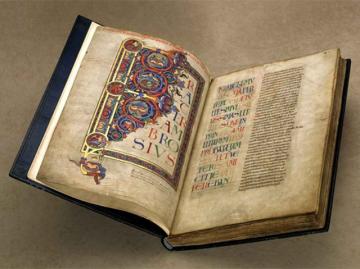
On the afternoon of the 25th of May, a group of Ertegun Scholars was toured around one of Oxford’s most remarkable buildings: the Weston Library. Part of the well-known Bodleian Libraries, the Weston was first built in the 1930s but underwent an impressive £80m refurbishment between 2011–2015. As explained on its website, “the Weston Library provides a new home for the Bodleian's special collections and create[s] high quality storage for its collections, to develop the space for both advanced research and to extend public access to the Libraries' treasures.” Our tour guide—none other but Richard Ovenden, 25th Bodley’s Librarian—pointed to the improved light conditions and public access of the new building as he walked us through endless corridors of bookshelves, locked doors, and study areas. Chris Wilkinson (Wilkinson Eyre Architects), the lead architect of the project, preserved some of the details of the original infrastructure, including light features, door knobs, and floor tiles. Yet the character has changed dramatically, particularly in relation to light. The Weston library is now a building within a building (not unlike the Atrium of the British Museum), allowing light to shine through layers of stone, concrete, and skylights onto numerous study desks often populated by students like us.
More than for a modern appearance, the Weston was renewed in order to safely house one of the largest collections of rare books and manuscripts in England. Christopher Fletcher, the Keeper of Special Collections at the Bodleian Library, also accompanied us while we had the unique opportunity to see and touch some of the library’s most recent acquisitions. The books/prints, we learned, are purchased by the Bodleian to enhance the important collections that Oxford already possesses (e.g. the largest collection of Georgian literature outside the Caucasus, and its extraordinary range of medieval manuscripts).
As part of our visit, we were also shown the Conversation Lab of the Weston. The main room of the lab is lit by a continuous row of windows, which offer an environment of well-distributed, natural light. At the time of our tour, we were told some facts about the work of conservation, and were shown the lab’s most current project. Directly from Winchester, the Weston conservators were rebinding and restoring the cathedral’s wonderful twelfth-century bible, probably the greatest medieval illuminated manuscript in Britain, and now divided into four volumes bound in the original medieval style (including oak wood planks, naturally). From the conservation lab, it is only a short climb to the top terrace of the Weston, open to the public every Friday afternoon. The view over Broad Street and the Sheldonian is certainly a highlight of the new library.
At the end of our tour, we were graced with refreshments and the opportunity to ask questions. The Weston is, in fact, a repository of invaluable treasures, and home to some of the most extraordinary pieces of literature and cartography created by both western and eastern civilisations. We learned that many of these treasures remain undiscovered, waiting to be once again brought to light from the vaults of the library.
Mariana Losa E Ferreira de Castro